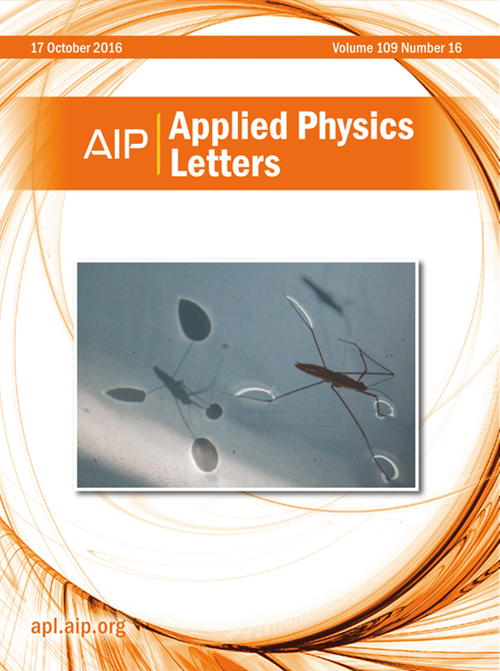不同Ti浓度的CoFe/TixW1−x双分子层的自旋抽运阻尼和太赫兹发射研究
IF 3.5
2区 物理与天体物理
Q2 PHYSICS, APPLIED
引用次数: 0
摘要
利用时间分辨磁光克尔效应和时域太赫兹发射光谱系统地研究了不同钛浓度的CoFe/TixW1 - x双分子层的激光诱导磁化动力学和太赫兹(THz)发射。在重金属W中掺入Ti会导致自旋泵振阻尼显著降低,特别是当Ti浓度低于50%时。同样,太赫兹辐射峰值振幅随Ti浓度的增加而减小。这两种效应主要归因于CoFe/TixW1−x界面处自旋电流透射率的降低,这是由于TixW1−x层的电导率大幅降低造成的。有趣的是,当自旋泵振阻尼继续减小时,太赫兹发射振幅在x = 63%处开始增加,此时由于W和Ti的自旋霍尔角相反,太赫兹信号趋于零。这种行为强调了控制自旋泵阻尼和太赫兹发射的独特而相关的机制,反映了它们对铁磁体/非磁性金属双层体系中自旋电流反射、传播、耗散和自旋到电荷转换的特定依赖。这些发现增强了我们对超快自旋动力学和自旋输运性质的理解,为推进小型化和高速自旋电子器件的发展提供了有价值的见解。本文章由计算机程序翻译,如有差异,请以英文原文为准。
Study of spin pumping damping and THz emission in CoFe/TixW1−x bilayers with various Ti concentrations
Laser-induced magnetization dynamics and terahertz (THz) emission in CoFe/TixW1−x bilayers with varying Ti concentrations are systematically investigated using the time-resolved magneto-optical Kerr effect and time-domain THz emission spectroscopy. The incorporation of Ti into heavy metal W leads to a significant reduction in spin pumping damping, particularly for Ti concentrations below 50%. Similarly, the THz emission peak amplitude decreases with increasing Ti concentration. Both effects are attributed primarily to the reduced spin current transmittance at the CoFe/TixW1−x interface, caused by the substantially decreased electrical conductivity of the TixW1−x layer. Interestingly, while spin pumping damping continues to decrease, the THz emission amplitude starts to increase at x = 63%, where the THz signal approaches zero due to the opposite spin Hall angles of W and Ti. This behavior underscores the distinct yet correlated mechanisms governing spin pumping damping and THz emission, reflecting their specific dependences on spin current reflection, propagation, dissipation, and spin-to-charge conversion in ferromagnet/nonmagnetic metal bilayer systems. These findings enhance our understanding of ultrafast spin dynamics and spin transport properties, offering valuable insights for advancing the development of miniaturized and high-speed spintronic devices.
求助全文
通过发布文献求助,成功后即可免费获取论文全文。
去求助
来源期刊

Applied Physics Letters
物理-物理:应用
CiteScore
6.40
自引率
10.00%
发文量
1821
审稿时长
1.6 months
期刊介绍:
Applied Physics Letters (APL) features concise, up-to-date reports on significant new findings in applied physics. Emphasizing rapid dissemination of key data and new physical insights, APL offers prompt publication of new experimental and theoretical papers reporting applications of physics phenomena to all branches of science, engineering, and modern technology.
In addition to regular articles, the journal also publishes invited Fast Track, Perspectives, and in-depth Editorials which report on cutting-edge areas in applied physics.
APL Perspectives are forward-looking invited letters which highlight recent developments or discoveries. Emphasis is placed on very recent developments, potentially disruptive technologies, open questions and possible solutions. They also include a mini-roadmap detailing where the community should direct efforts in order for the phenomena to be viable for application and the challenges associated with meeting that performance threshold. Perspectives are characterized by personal viewpoints and opinions of recognized experts in the field.
Fast Track articles are invited original research articles that report results that are particularly novel and important or provide a significant advancement in an emerging field. Because of the urgency and scientific importance of the work, the peer review process is accelerated. If, during the review process, it becomes apparent that the paper does not meet the Fast Track criterion, it is returned to a normal track.
 求助内容:
求助内容: 应助结果提醒方式:
应助结果提醒方式:


